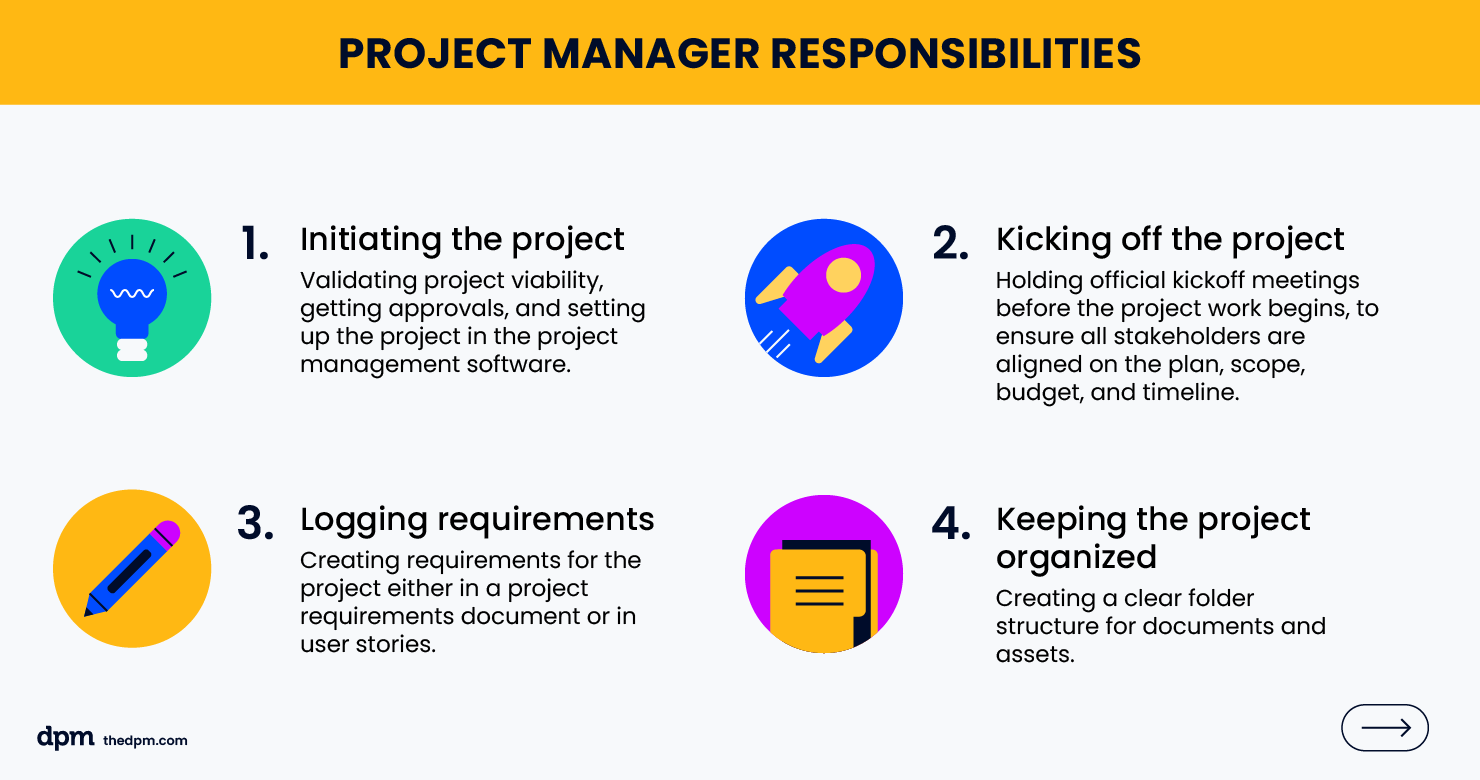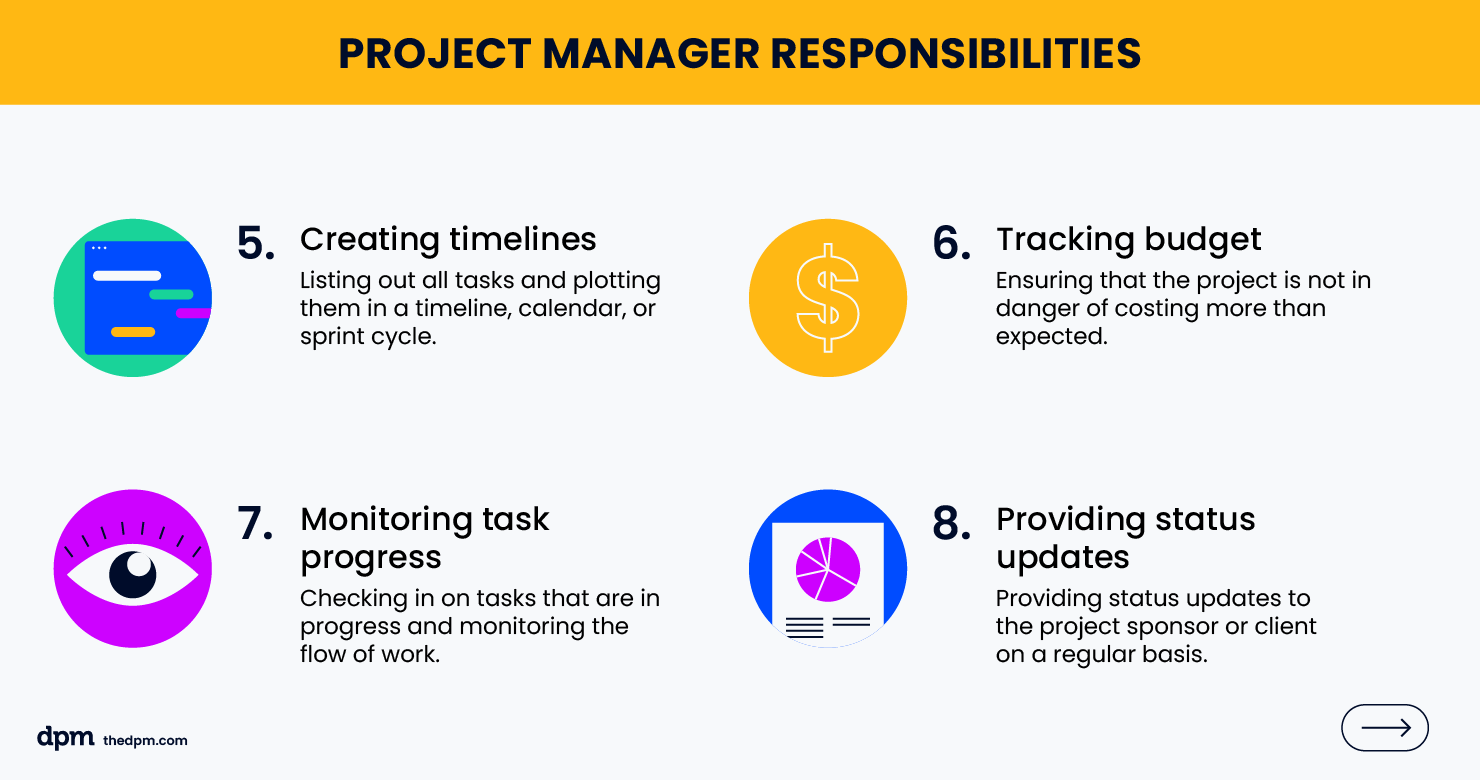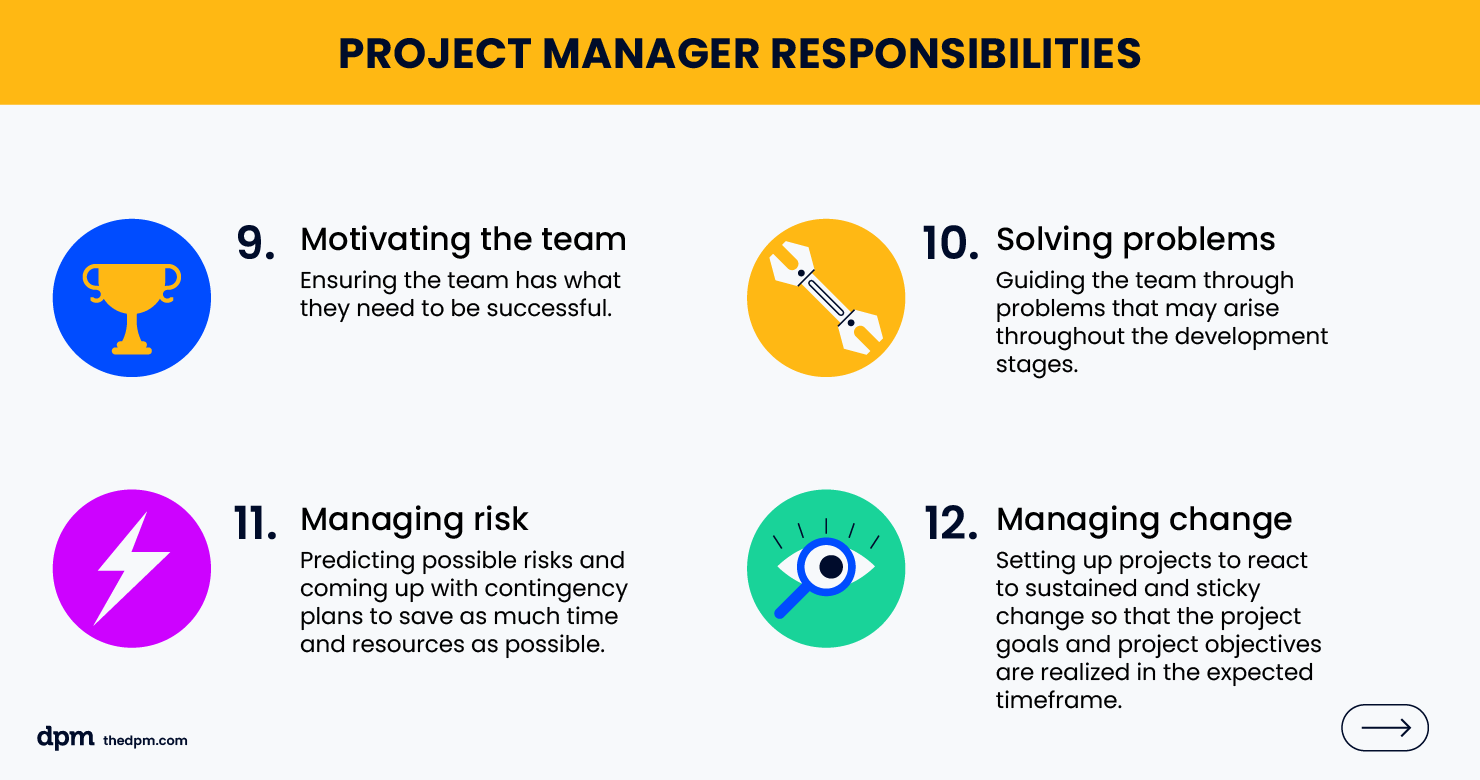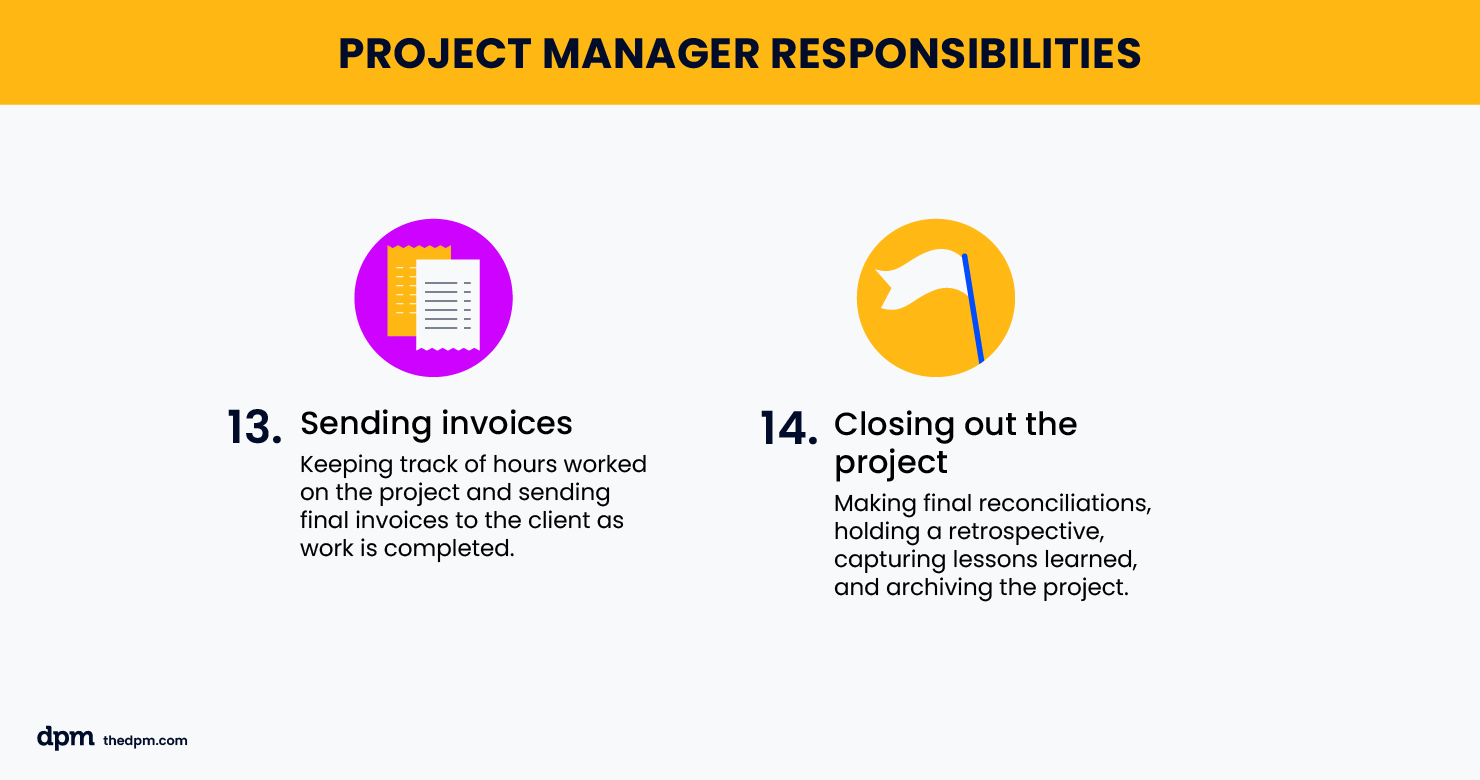Project manager responsibilities go beyond just overseeing tasks and timelines—you're leading the team through a maze of challenges and opportunities. You're expected to keep things on the right track and keep deliverables and the project moving forward steadily.
This article will cover exactly what you're supposed to be doing as a project manager, and how to achieve success in this important role.
What Does A Project Manager Do?
The main responsibility that project managers have is to execute projects from beginning to end. Project managers own the delivery of the project in a way that drives business outcomes and value for the end user.
This includes:
- Initiating and planning the project
- Controlling costs, scope, and schedule
- Overseeing the team and the individual tasks and deliverables they're completing
- Ensuring quality
- Preventing risks from derailing the whole thing
- Managing the collaborative effort between the project team, internal & external stakeholders, vendors, and suppliers.
The project manager job description has changed over the years, and nowadays the role of a project manager goes beyond executing directives to include driving the strategy behind the project and exhibiting leadership. This comes with a lot more expectations on the shoulders of project managers.
What Are A Project Manager's Responsibilities & What Is Their Role?
A project manager's role includes keeping the project on time, organized, and on budget. The responsibilities of a project manager in this regard include:
- Initiating the project
- Kicking off the project
- Logging requirements
- Keeping the project organized
- Creating timelines
- Tracking budget
- Monitoring task progress
- Providing status updates
- Motivating the team
- Solving problems
- Managing risk
- Managing change
- Sending invoices
- Closing out the project
1. Initiate The Project
Project managers validate project viability, get approvals, and set up the project in their project management software.
Smart organizations give their project management team an opportunity to create or vet scope, budget, and timeline during the sales or shaping phase. You’ll discuss the brief with the project sponsors, create a high-level estimate and timeline, and review the plan with key stakeholders to secure approvals.
Next, you'll:
- Set up your project management tool and file folders
- Create an updated project brief
- Secure the team you need
- Kick off the project internally,
- Work with your team to build a detailed Statement of Work (or potentially a project initiation document) with a more defined timeline, budget, and requirements.
2. Kick Off The Project
Project managers hold official kickoff meetings before the project work begins, to ensure all stakeholders are aligned on the plan, scope, budget, and timeline.
Once the Statement of Work is approved, work can begin. Your first project management task is getting everyone aligned during an external kickoff meeting with key stakeholders and the project sponsor. You'll also create the foundational assets you’ll use to monitor and communicate expectations around the project.
Some examples of these assets could be:
- A shareable project plan
- A RAID log
- The communications plan
- A RACI chart
- Your status report template
3. Log Requirements
Project managers create requirements for the project either in a project requirements document or in user stories.
Refer to the Statement of Work (SOW) and client notes when you're creating the requirements document. You also need to understand the overall business needs of the project. Your requirements and user stories should reflect the project scope and the overall why reason the project is happening.
If you have a good grasp of the strategy behind the project, you'll be able to answer most questions from the team or other stakeholders and provide strategic guidance to the team without waiting for additional input on items that don’t require a customer decision.
4. Keep The Project Organized
Project managers create a clear folder structure for documents and assets.
One important project manager duty is to keep all the information pertaining to the project in a single place that everyone has access to. Usually, this lives on a shared drive, a Google Drive, Dropbox, and/or digital asset management software.
You also need to make sure that assets and information for a project are in the best order possible so that they are ready to go when needed. Project management software or other project management tools come in handy here. Do this at the beginning of the project to ensure you don’t lose time or money later on trying to fix something preventable.
5. Create A Timeline
Project managers list out all tasks and plot them in a timeline, calendar, or sprint cycle.
How you create your project timeline really depends on the project schedule. If it is immovable, you create a timeline from that immovable end date and work backwards. If it is flexible, you create a timeline starting from the present time and work out a suitable launch date.
You also need to think about contingencies. Start thinking about where things might go wrong and what you’ll do about it if that happens. Whatever tactics you choose, identify where in your timeline you’d be able to execute them. These don’t have to be shared with your client, or even your team. They are mainly for you to have in your back pocket should something happen.
6. Track Budget
Project managers ensure that the project is not in danger of costing more than expected.
Usually, projects will have a fixed budget that is decided before the project manager is involved. Your job is allocate that budget to the different phases, milestones, and tasks throughout the project life cycle. Ensure you have enough budget to get the job done because it will be harder to get more budget as the project progresses (unless there are obvious out-of-scope requests).
One of your key responsibilities is slicing the overall budget into hour buckets both by role and by task. Your budget doesn’t just track the spending on a project, it sets boundaries for each person on your project team.
7. Monitor Task Progress
Project managers check in on tasks that are in progress and monitor the flow of work versus the project plan in their project management software.
In a more waterfall-style project, that might mean spending some time updating your Gantt chart to see if you are at risk of being off your critical path.
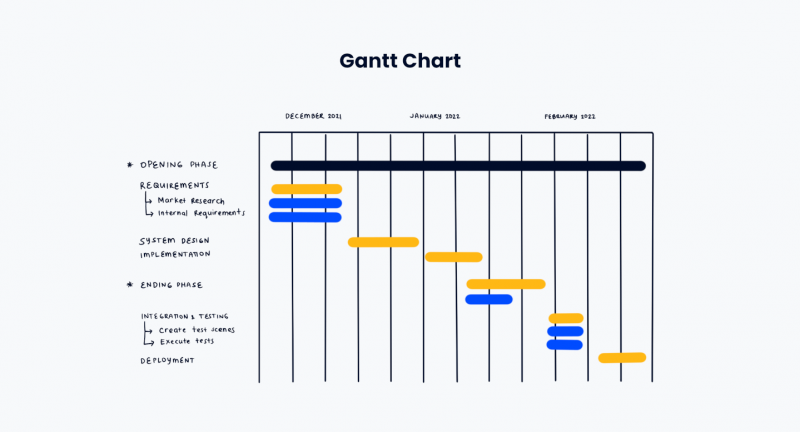
On a more agile project, that might mean assessing the team’s actual velocity versus planned and looking at your burndown chart to see if changes need to be made to the scope to accommodate the timeline (or vice versa).
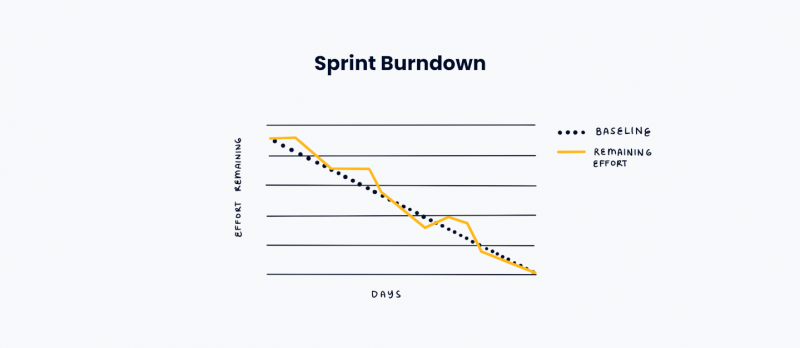
8. Provide Status Updates
Project managers provide formal and/or informal status updates to the project sponsor or client on a regular basis.
This important project management task ensures you are communicating progress and accounting for changes in the project scope or schedule. In addition to more frequent updates to project sponsors or clients, it’s a good practice to create a formal point-in-time status report for your project. This includes progress to date, upcoming milestones, the status of key risks and dependencies, and issues that need to be discussed.
You also need to provide updates to the broader stakeholder ecosystem. This might include formal updates sent to end-users and departments impacted by the project as well as demos and presentations to security teams, compliance teams, and regulatory bodies.
9. Motivate The Team
Project managers ensure the team has what they need to be successful.
You have to make sure things keep happening according to the project management plan, and that everyone has what they need for the task at hand.
Regular check-ins with the team are one of the most important daily project management tasks. They allow you to understand how work is progressing, and it’s an opportunity to solidify rapport, motivate the team, maintain transparency and accountability, and help the team understand how each of their efforts feed into the project’s bigger picture.
These check-ins could be a daily stand-up with the team, 1:1 meetings with the individuals doing the work, or asynchronous check-ins. Just remember: it’s best framed as a conversation, not an interrogation.
10. Solve Problems
Project managers guide the team through problems that may arise throughout the development stages.
As a project manager, your job is to address problems in a timely manner so they don’t knock your budget and schedule off track. Provide your team with the trust and safe space for creative and critical problem-solving.
This is one of the most misunderstood project management tasks. For example: “What can a project manager do to help unblock a developer or designer or business analyst?”
The answer is: lots. Ask questions that look at the problem and its possible solutions from a different angle:
- You can request additional support or engage another SME to provide a second opinion.
- You can reprioritize the work to accommodate any delays.
- You can make sure the blocker is impactful in the grand scheme of the project and help the team work around it.
11. Manage Risk
Project managers predict possible risks and come up with contingency plans to save as much time and resources as possible.
Good project managers have the know-how to identify, analyze, prioritize, plan for, monitor, and respond to risks. This reduces and mitigates the impact should they come to fruition. You need to have conversations with your team to understand potential risks, how they could negatively impact the project, and their likelihood, and to create a risk management plan.
Cordon off a bit of time at every team meeting to discuss risks. You're also managing expectations with your clients, your stakeholders, and your leadership team. Use day-to-day communications like status reports to keep everyone in the loop.
12. Manage Change
Project managers set up projects to react to sustained and sticky change so that the project goals and project objectives are realized in the expected timeframe.
You need to consider how the output of your project will be handed over and put into use. Reach out and build relationships with the team managing the change that the project will bring, so that the information they are relaying to staff is accurate, timely, and useful. Approach them about any adoption risks and ask about the plan to make sure they receive a return on their investment.
The other side of change management involves changes to the project scope. As work is executed and communicated, new requirements may be uncovered. Addressing scope changes swiftly will prevent delays to the project timeline, will set expectations upfront, and will build trust in your judgment as a project manager.
13. Send Invoices
Project managers keep track of hours worked on the project and send final invoices to the client as work is completed.
Ensure you understand the payment terms for your vendors and remit accordingly. If you are in a client services organization, this also means being proactive about invoicing your client based on your engagement model.
You’ll want to stay on top of analyzing and approving timesheets from the previous week in your time tracking software, so you have this information readily available for the invoice.
If it’s milestone-based billing, know where these milestones are in your project schedule. If it’s time and materials, always be reconciling and forecasting the monthly invoice amount.
14. Close Out The Project
Project managers close out a project once it's complete by making final reconciliations, holding a retrospective, capture lessons learned, and archiving the project.
You’ll be asked to report on how well your project performed in reality versus the expectation, so get ahead of it. Ensure all timesheets have been submitted and that you have documentation to discuss if/where things went off rails versus planned changes to the scope, timeline, and budget.
Conduct a project retrospective (also known as a post-mortem) with your project team and key stakeholders. Use the feedback and insights you receive to inform your lessons learned, and document them for future projects.
Next, archive the project by gathering all the assets and deliverables and put them in whatever archiving system you may be using. It's also worth taking a moment to celebrate with the team. As the project leader, this is something you can own so that you continue to build trust, loyalty, and rapport.
Here's an inside look at what project managers do and how to get started:
Essential Project Manager Skills
There are a variety of project management skills (both hard skills and soft skills) that you'll need to succeed in the role:
- Organization
- Project planning
- Teamwork and collaboration
- Prioritization
- Critical thinking
- Problem solving
- Risk management
- Leadership
- Communication
- Project scheduling
- Process management
- Research
- Documentation Development
- Diplomacy
- Time management
Crafting Your Career Path In Project Management
If you're considering project management as a career, there are plenty of resources out there to help you get the training and skill set you need to become a successful project manager. Or maybe you're a beginner who's been dropped into managing projects and you're not sure where to begin.
Here's some ideas for where to turn:
- The DPM's Mastering Digital Project Management course is a digital-specific training program that includes a certification. You'll get hands-on, scenario-based learning that hones your instinct, judgment, and leadership skills.
- The Project Management Professional (PMP) certification from the Project Management Institute (PMI) is a globally-recognized project management certification that requires a few years of experience (unlike the DPM course, which doesn't have any prerequisites).
- There are many other one-off courses and training programs out there, including courses from Google and Coursera, as well as degree programs at accredited universities for those who want a bachelors or masters degree. You might also be interested in specialized courses for specific project methodologies, such as agile project management or Scrum.
- Your other option is to just get in there and starting managing projects. You'll get hands-on experience that will be invaluable in your career. You can read project management books and articles as you go (there are plenty on The DPM!) to supplement your experience.
What's Next?
If you're looking for networking opportunities, to talk through challenges you're facing in your projects, or just to vent for a minute, DPM Membership is the place for you! You'll also get access to 100+ templates and examples, and access to the conversation in Slack with 100's of other digital project managers!


